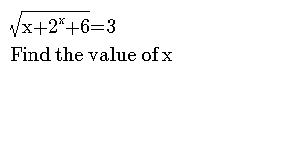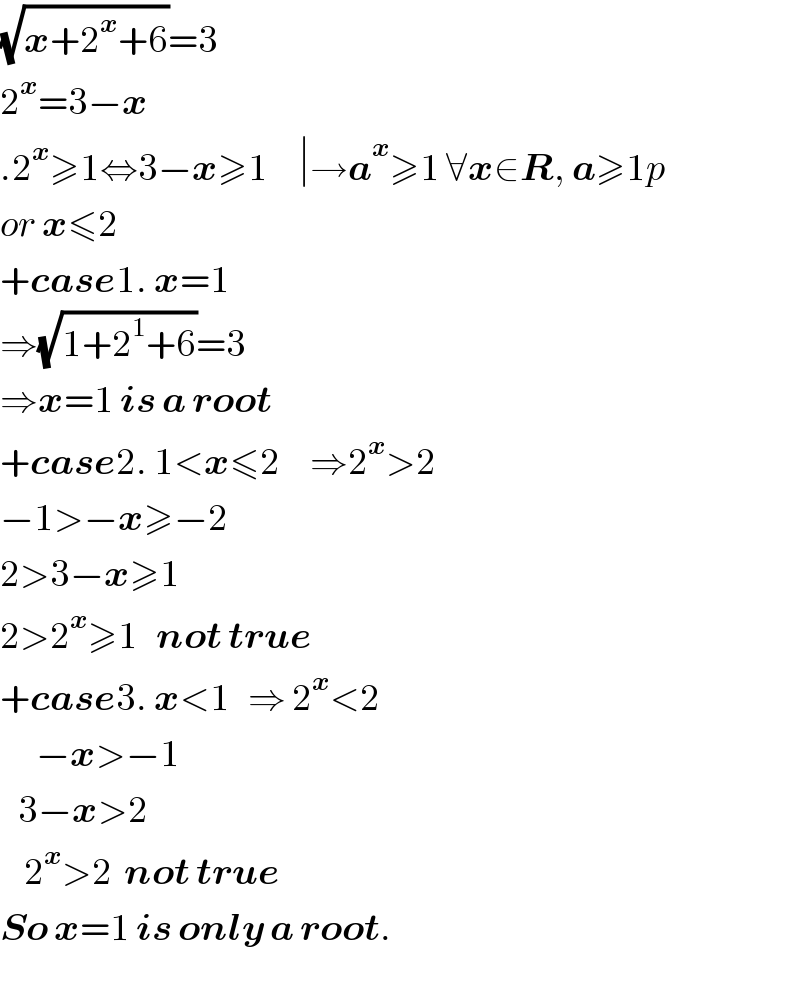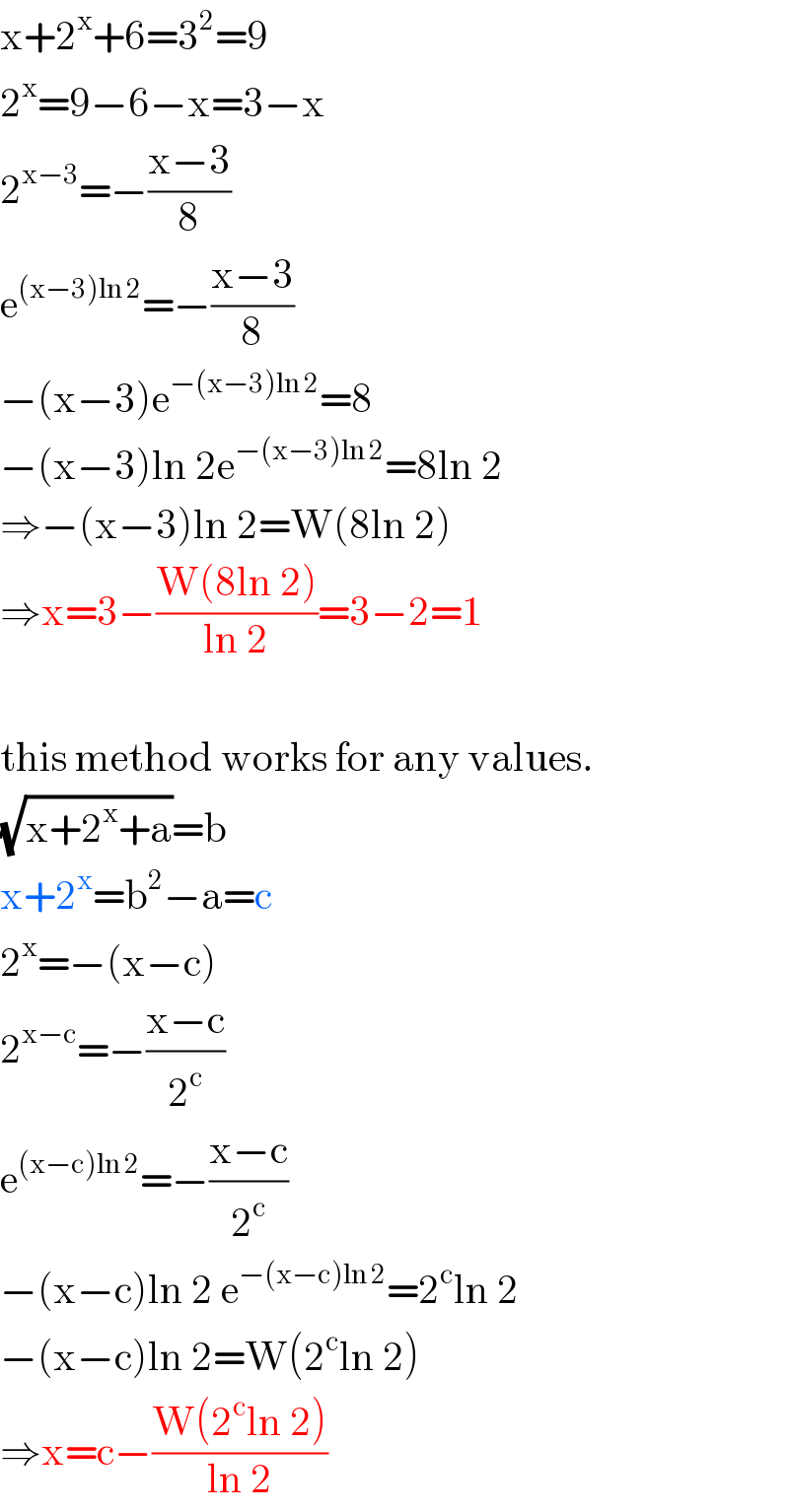
Question Number 22199 by chernoaguero@gmail.com last updated on 13/Oct/17

Commented by chernoaguero@gmail.com last updated on 13/Oct/17

$$\mathrm{Thank}\:\mathrm{you}\:\mathrm{guys} \\ $$
Commented by Rasheed.Sindhi last updated on 13/Oct/17

$$\mathrm{x}=\mathrm{1} \\ $$
Commented by prakash jain last updated on 13/Oct/17

$$\frac{{d}}{{dx}}\left({x}+\mathrm{2}^{{x}} +\mathrm{6}\right)=\mathrm{1}+\left(\mathrm{ln}\:\mathrm{2}\right)\mathrm{2}^{{x}} >\mathrm{0} \\ $$$${x}+\mathrm{2}^{{x}} +\mathrm{6}\:\mathrm{is}\:\mathrm{increasing}\:\mathrm{function} \\ $$$$\mathrm{so}\:\mathrm{only}\:\mathrm{1}\:\mathrm{solution}. \\ $$
Answered by Bruce Lee last updated on 13/Oct/17

$$\sqrt{\boldsymbol{{x}}+\mathrm{2}^{\boldsymbol{{x}}} +\mathrm{6}}=\mathrm{3} \\ $$$$\mathrm{2}^{\boldsymbol{{x}}} =\mathrm{3}−\boldsymbol{{x}}\: \\ $$$$.\mathrm{2}^{\boldsymbol{{x}}} \geqslant\mathrm{1}\Leftrightarrow\mathrm{3}−\boldsymbol{{x}}\geqslant\mathrm{1}\:\:\:\:\:\mid\rightarrow\boldsymbol{{a}}^{\boldsymbol{{x}}} \geqslant\mathrm{1}\:\forall\boldsymbol{{x}}\in\boldsymbol{{R}},\:\boldsymbol{{a}}\geqslant\mathrm{1}{p} \\ $$$${or}\:\boldsymbol{{x}}\leqslant\mathrm{2} \\ $$$$+\boldsymbol{{case}}\mathrm{1}.\:\boldsymbol{{x}}=\mathrm{1} \\ $$$$\Rightarrow\sqrt{\mathrm{1}+\mathrm{2}^{\mathrm{1}} +\mathrm{6}}=\mathrm{3}\: \\ $$$$\Rightarrow\boldsymbol{{x}}=\mathrm{1}\:\boldsymbol{{is}}\:\boldsymbol{{a}}\:\boldsymbol{{root}} \\ $$$$+\boldsymbol{{case}}\mathrm{2}.\:\mathrm{1}<\boldsymbol{{x}}\leqslant\mathrm{2}\:\:\:\:\:\Rightarrow\mathrm{2}^{\boldsymbol{{x}}} >\mathrm{2} \\ $$$$−\mathrm{1}>−\boldsymbol{{x}}\geqslant−\mathrm{2} \\ $$$$\mathrm{2}>\mathrm{3}−\boldsymbol{{x}}\geqslant\mathrm{1} \\ $$$$\mathrm{2}>\mathrm{2}^{\boldsymbol{{x}}} \geqslant\mathrm{1}\:\:\:\boldsymbol{{not}}\:\boldsymbol{{true}} \\ $$$$+\boldsymbol{{case}}\mathrm{3}.\:\boldsymbol{{x}}<\mathrm{1}\:\:\:\Rightarrow\:\mathrm{2}^{\boldsymbol{{x}}} <\mathrm{2} \\ $$$$\:\:\:\:\:\:−\boldsymbol{{x}}>−\mathrm{1} \\ $$$$\:\:\:\mathrm{3}−\boldsymbol{{x}}>\mathrm{2} \\ $$$$\:\:\:\:\mathrm{2}^{\boldsymbol{{x}}} >\mathrm{2}\:\:\boldsymbol{{not}}\:\boldsymbol{{true}} \\ $$$$\boldsymbol{{So}}\:\boldsymbol{{x}}=\mathrm{1}\:\boldsymbol{{is}}\:\boldsymbol{{only}}\:\boldsymbol{{a}}\:\boldsymbol{{root}}. \\ $$
Commented by chernoaguero@gmail.com last updated on 13/Oct/17

$$\mathrm{Thank}\:\mathrm{you}\:\mathrm{sir} \\ $$
Answered by mrW1 last updated on 14/Oct/17

$$\mathrm{x}+\mathrm{2}^{\mathrm{x}} +\mathrm{6}=\mathrm{3}^{\mathrm{2}} =\mathrm{9} \\ $$$$\mathrm{2}^{\mathrm{x}} =\mathrm{9}−\mathrm{6}−\mathrm{x}=\mathrm{3}−\mathrm{x} \\ $$$$\mathrm{2}^{\mathrm{x}−\mathrm{3}} =−\frac{\mathrm{x}−\mathrm{3}}{\mathrm{8}} \\ $$$$\mathrm{e}^{\left(\mathrm{x}−\mathrm{3}\right)\mathrm{ln}\:\mathrm{2}} =−\frac{\mathrm{x}−\mathrm{3}}{\mathrm{8}} \\ $$$$−\left(\mathrm{x}−\mathrm{3}\right)\mathrm{e}^{−\left(\mathrm{x}−\mathrm{3}\right)\mathrm{ln}\:\mathrm{2}} =\mathrm{8} \\ $$$$−\left(\mathrm{x}−\mathrm{3}\right)\mathrm{ln}\:\mathrm{2e}^{−\left(\mathrm{x}−\mathrm{3}\right)\mathrm{ln}\:\mathrm{2}} =\mathrm{8ln}\:\mathrm{2} \\ $$$$\Rightarrow−\left(\mathrm{x}−\mathrm{3}\right)\mathrm{ln}\:\mathrm{2}=\mathrm{W}\left(\mathrm{8ln}\:\mathrm{2}\right) \\ $$$$\Rightarrow\mathrm{x}=\mathrm{3}−\frac{\mathrm{W}\left(\mathrm{8ln}\:\mathrm{2}\right)}{\mathrm{ln}\:\mathrm{2}}=\mathrm{3}−\mathrm{2}=\mathrm{1} \\ $$$$ \\ $$$$\mathrm{this}\:\mathrm{method}\:\mathrm{works}\:\mathrm{for}\:\mathrm{any}\:\mathrm{values}. \\ $$$$\sqrt{\mathrm{x}+\mathrm{2}^{\mathrm{x}} +\mathrm{a}}=\mathrm{b} \\ $$$$\mathrm{x}+\mathrm{2}^{\mathrm{x}} =\mathrm{b}^{\mathrm{2}} −\mathrm{a}=\mathrm{c} \\ $$$$\mathrm{2}^{\mathrm{x}} =−\left(\mathrm{x}−\mathrm{c}\right) \\ $$$$\mathrm{2}^{\mathrm{x}−\mathrm{c}} =−\frac{\mathrm{x}−\mathrm{c}}{\mathrm{2}^{\mathrm{c}} } \\ $$$$\mathrm{e}^{\left(\mathrm{x}−\mathrm{c}\right)\mathrm{ln}\:\mathrm{2}} =−\frac{\mathrm{x}−\mathrm{c}}{\mathrm{2}^{\mathrm{c}} } \\ $$$$−\left(\mathrm{x}−\mathrm{c}\right)\mathrm{ln}\:\mathrm{2}\:\mathrm{e}^{−\left(\mathrm{x}−\mathrm{c}\right)\mathrm{ln}\:\mathrm{2}} =\mathrm{2}^{\mathrm{c}} \mathrm{ln}\:\mathrm{2} \\ $$$$−\left(\mathrm{x}−\mathrm{c}\right)\mathrm{ln}\:\mathrm{2}=\mathrm{W}\left(\mathrm{2}^{\mathrm{c}} \mathrm{ln}\:\mathrm{2}\right) \\ $$$$\Rightarrow\mathrm{x}=\mathrm{c}−\frac{\mathrm{W}\left(\mathrm{2}^{\mathrm{c}} \mathrm{ln}\:\mathrm{2}\right)}{\mathrm{ln}\:\mathrm{2}} \\ $$
